Application of Semi-Empirical Ventilation Models in A Mediterranean Greenhouse with Opposing Thermal and Wind Effects. Use of Non-Constant Cd (Pressure Drop Coefficient Through the Vents) and Cw (Wind Effect Coefficient)
Abstract
:1. Introduction
2. Materials and Methods
2.1. Experimental Setup
2.2. Equipment and Instrumentation
2.3. Ventilation Models
- (1)
- Model 1. In this model, the flow is driven by the sum of two independent pressure fields. In a greenhouse with side and roof openings, G is calculated as the vector sum of the free component of the flux induced by buoyancy forces GT and the flux induced by wind forces Gw:where SVR and SVS are the roof and side total vent areas, respectively [m2], g is the gravitational constant [m s−2], ∆Tio is the inside-outside temperature difference [K], To is the outside temperature [K], uo is the outside wind speed [m s−1], Cd is the discharge coefficient (CdVR, roof vent; CdVS, side vents), Cw is the wind effect coefficient, and hSR is the vertical distance between the mid-point of the side and the roof vents [m].
- (2)
- Model 2. In this model, the flow is driven by the sum of two independent fluxes. The greenhouse volumetric flow rate is calculated as the algebraic sum of the free component of the flux induced by buoyancy forces GT and the flux induced by wind forces Gw:
- (3)
- Model 3. In this model, only the wind effect is considered, neglecting the thermal effect:
2.4. Anemometric Measurement of Volumetric Flow Rate
2.5. Estimation of the Pressure Drop/discharge Coefficient of the Greenhouse Openings
2.6. Statistical Analysis
3. Results and Discussion
3.1. Airflow Inside the Greenhouse
3.2. Evaluation of the Mean and Turbulent Ventilation Flows
3.3. Application of the Semi-empirical Ventilation Models Based on Bernoulli’s Equation
3.3.1. Determining the Discharge Coefficient of the Vents Cd
3.3.2. Determining the Wind Effect Coefficient Cw
3.3.3. Fitting the Semi-Empirical Models to Experimental Data
3.3.4. Estimating the Contribution of the Thermal Effect in the Natural Ventilation of the Greenhouse
3.3.5. Estimating the Reduction in the Ventilation Rate Caused by the Insect-Proof Screens
4. Conclusions
Author Contributions
Funding
Acknowledgments
Conflicts of Interest
Abbreviations
| MD | bias |
| NSE | Nash-Sutcliffe efficiency |
| PBIAS | percent bias |
| RMSD | root mean squared deviation |
| RSR | RMSD-observations standard deviation ratio |
| Nomenclature | |
| Cd | total discharge coefficient of the opening |
| Cw | wind effect coefficient for the mean airflow |
| e | thickness of the screen [m] |
| EG | error in the calculation of volumetric flow rates [%] |
| Ev | coefficient of effectiveness of the openings |
| G | gravitational constant [m s−2] |
| G | volumetric flow rate [m3 s−1] |
| GT | free component of the ventilation flux induced by buoyancy forces [m3 s−1] |
| Gw | forced component of the ventilation flux induced by wind forces [m3 s−1] |
| hSR | difference in height between side and roof openings [m] |
| RH | relative humidity [%] |
| Kp | screen permeability [m2] |
| n | number of measurement points in vents |
| Rg | solar radiation [W m−2] |
| RM | ventilation rate for greenhouse [h−1] |
| SA | greenhouse area [m2] |
| SV | surface area of the vent openings [m2] |
| t | time [s] |
| T | temperature [°C] |
| u | air velocity [m s−1] |
| Y | inertial factor |
| Greek Letters | |
| Δ | difference |
| δ | ratio for wind/thermal effect |
| θ | wind direction [°] |
| φ | porosity [%] |
| Subscripts | |
| i | inside |
| j | measurement point |
| L | leeward |
| M | average value for the greenhouse |
| M1 | ventilation model 1 |
| M2 | ventilation model 2 |
| M3 | ventilation model 3 |
| o | outside |
| obs | observed |
| R | roof vent |
| S | side vent |
| sim | simulated |
| V | vent |
| W | windward |
| x | longitudinal component |
| y | transversal component |
| z | vertical component |
| Superscripts | |
| * | corrected |
| ’ | fluctuating component |
References
- Boulard, T.; Meneses, J.F.; Mermier, M.; Papadakis, G. The mechanisms involved in the natural ventilation of greenhouses. Agric. Forest. Meteorol. 1996, 79, 61–77. [Google Scholar] [CrossRef]
- Kittas, C.; Boulard, T.; Mermier, M.; Papadakis, G. Wind induced air exchange rates in a greenhouse tunnel with continuous side openings. J. Agric. Eng. Res. 1996, 65, 37–49. [Google Scholar] [CrossRef]
- Valera, D.L.; Belmonte, L.J.; Molina-Aiz, F.D.; López, A. Greenhouse Agriculture in Almería. A Comprehensive Techno-Economic Analysis, 1st ed.; Cajamar Caja Rural: Almería, Spain, 2016; p. 408. [Google Scholar]
- Kittas, C.; Boulard, T.; Papadakis, G. Natural ventilation of a greenhouse with ridge and side openings: Sensitivity to temperature and wind effects. Trans. ASAE 1997, 40, 415–425. [Google Scholar] [CrossRef]
- Morris, L.G.; Neale, F.E. The Infra-Red Carbon Dioxide Gas Analyser and Its use in Glasshouse Research; Tech. Memo. No. 99; National Institute of Agricultural Engineering: Silsoe, UK, 1954; p. 13. [Google Scholar]
- Businger, J.A. The glasshouse (greenhouse) climate. In Physics of Plant Environmen, 1st ed.; van Wijk, W.R., Ed.; North-Holland Publishing Co.: Amsterdam, The Netherlands, 1963; pp. 277–318. [Google Scholar]
- Boulard, T.; Baille, A. Modelling of air exchange rate in a greenhouse equipped with continuous roof vents. J. Agric. Eng. Res. 1995, 61, 37–48. [Google Scholar] [CrossRef]
- Bruce, J.M. Natural convection through openings and its applications to cattle building ventilation. J. Agric. Eng. Res. 1978, 23, 151–167. [Google Scholar] [CrossRef]
- Bruce, J.M. Ventilation of a model livestock building by thermal buoyancy. Trans. ASAE 1982, 25, 1724–1726. [Google Scholar] [CrossRef]
- Boulard, T.; Feuilloley, P.; Kittas, C. Natural ventilation performance of six greenhouse and tunnel types. J. Agric. Eng. Res. 1997, 67, 249–266. [Google Scholar] [CrossRef]
- Papadakis, G.; Mermier, M.; Meneses, J.F.; Boulard, T. Measurement and analysis of air exchange rates in a greenhouse with continuous roof and side openings. J. Agric. Eng. Res. 1996, 63, 219–228. [Google Scholar] [CrossRef]
- Demrati, H.; Boulard, T.; Bekkaoui, A.; Bouirden, L. Natural ventilation and microclimatic performance of a large-scale banana greenhouse. J. Agric. Eng. Res. 2001, 80, 261–271. [Google Scholar] [CrossRef]
- Fatnassi, H.; Boulard, T.; Demrati, H.; Bouirden, L.; Sappe, G. SE-Structures and Environment: Ventilation Performance of a Large Canarian-Type Greenhouse equipped with Insect-proof Nets. Biosyst. Eng. 2002, 82, 97–105. [Google Scholar] [CrossRef]
- Sase, S.; Reiss, E.; Both, A.J.; Roberts, W.J. A natural ventilation model for open-roof greenhouses; Paper No. 024010. In Proceedings of the ASAE International Meeting/CIGR XVth World Congress, ASAE, Chicago, IL, USA, 28–31 July 2002. [Google Scholar]
- Fatnassi, H.; Boulard, T.; Lagier, J. Simple indirect estimation of ventilation and crop transpiration rates in a greenhouse. Biosyst. Eng. 2004, 88, 467–478. [Google Scholar] [CrossRef]
- Abreu, P.E.; Boulard, T.; Mermier, M.; Meneses, J.F. Parameter estimation and selection of a greenhouse natural ventilation model and its use on an energy balance model to estimate the greenhouse air temperature. Acta Hortic. 2006, 691, 611–618. [Google Scholar] [CrossRef]
- Katsoulas, N.; Bartzanas, T.; Boulard, T.; Mermier, M.; Kittas, C. Effect of vent openings and insect screens on greenhouse ventilation. Biosyst. Eng. 2006, 93, 427–436. [Google Scholar] [CrossRef]
- Teitel, M.; Liran, O.; Tanny, J.; Barak, M. Wind driven ventilation of a mono-span greenhouse with a rose crop and continuous screened side vents and its effect on flow patterns and microclimate. Biosyst. Eng. 2008, 101, 111–122. [Google Scholar] [CrossRef]
- Molina-Aiz, F.D.; Valera, D.L.; Peña, A.A.; Gil, J.A.; López, A. A Study of Natural Ventilation in an Almería-Type Greenhouse with Insect Screens by Means of Tri-sonic Anemometry. Biosyst. Eng. 2009, 104, 224–242. [Google Scholar] [CrossRef]
- Sase, S.; Takakura, T.; Nara, M. Wind tunnel testing on airflow and temperature distribution of a naturally ventilated greenhouse. Acta Hortic. 1984, 148, 329–336. [Google Scholar] [CrossRef]
- Bot, G.P.A. Greenhouse Climate: From Physical Processes to a Dynamic Model. Ph.D. Thesis, Agricultural University, Wageningen, The Netherlands, 1983. [Google Scholar]
- Li, Y.; Delsante, A. Natural ventilation induced by combined wind and thermal forces. Build. Environ. 2001, 36, 59–71. [Google Scholar] [CrossRef]
- Van Buggenhout, S.; Van Brecht, A.; Eren Özcan, S.; Vranken, E.; Van Malcot, W.; Berckmans, D. Influence of sampling positions on accuracy of tracer gas measurements in ventilated spaces. Biosyst. Eng. 2009, 104, 216–223. [Google Scholar] [CrossRef]
- Espinoza, K.; López, A.; Valera, D.L.; Molina-Aiz, F.D.; Torres, J.A.; Peña, A. Effects of ventilator configuration on the flow pattern of a naturally-ventilated three-span Mediterranean greenhouse. Biosyst. Eng. 2017, 164, 13–30. [Google Scholar] [CrossRef]
- Boulard, T.; Kittas, C.; Papadakis, G.; Mermier, M. Pressure Field and Airflow at the Opening of a Naturally Ventilated Greenhouse. J. Agric. Eng. Res. 1998, 71, 93–102. [Google Scholar] [CrossRef]
- Teitel, T.; Tanny, J.; Ben-Yakir, D.; Barak, M. Airflow patterns through roof openings of a naturally ventilated greenhouse and their effect on insect penetration. Biosyst. Eng. 2005, 92, 341–353. [Google Scholar] [CrossRef]
- Shilo, E.; Teitel, M.; Mahrer, Y.; Boulard, T. Air-flow patterns and heat fluxes in roof-ventilated multi-span greenhouse with insect-proof screens. Agric. Forest. Meteorol. 2004, 122, 3–20. [Google Scholar] [CrossRef]
- Boulard, T.; Papadakis, G.; Kittas, C.; Mermier, M. Air flow and associated sensible heat exchanges in a naturally ventilated greenhouse. Agric. Forest. Meteorol. 1997, 88, 111–119. [Google Scholar] [CrossRef]
- Valera, D.L.; Álvarez, A.J.; Molina-Aiz, F.D. Aerodynamic analysis of several insect-proof screens used in greenhouses. Span. J. Agris. Res. 2006, 4, 273–279. [Google Scholar] [CrossRef]
- López, A.; Molina-Aiz, F.D.; Valera, D.L.; Peña, A. Wind tunnel analysis of the airflow through insect-proof screens and comparison of their effect when installed in a Mediterranean greenhouse. Sensors 2016, 16, 690. [Google Scholar] [CrossRef] [PubMed]
- Kobayashi, K.; Salam, M.U. Comparing simulated and measured values using mean squared deviation and its components. Agron. J. 2000, 92, 345–352. [Google Scholar] [CrossRef]
- Nash, J.E.; Sutcliffe, J.V. River flow forecasting through conceptual models: Part 1. A discussion of principles. J. Hydrol. 1970, 10, 282–290. [Google Scholar] [CrossRef]
- Moriasi, D.N.; Arnold, J.G.; Van Liew, M.W.; Bingner, R.L.; Harmel, R.D.; Veith, T.L. Model evaluation guidelines for systematic quantification of accuracy in watershed simulations. Trans. ASABE 2007, 50, 885–900. [Google Scholar] [CrossRef]
- Gupta, H.V.; Sorooshian, S.; Yapo, P.O. Status of automatic calibration for hydrologic models: Comparison with multilevel expert calibration. J. Hydrol. Eng. 1999, 4, 135–143. [Google Scholar] [CrossRef]
- Singh, J.; Knapp, H.V.; Demissie, M. Hydrologic Modeling of the Iroquois River watershed using HSPF and SWAT. In ISWS CR 2004-08; Illinois State Water Survey: Champaign, IL, USA, 2004. [Google Scholar]
- Legates, D.R.; McCabe, G.J. Evaluating the use of “goodness-of-fit” measures in hydrologic and hydroclimatic model validation. Water Resour. Res. 1999, 35, 233–241. [Google Scholar] [CrossRef]
- López, A.; Valera, D.L.; Molina-Aiz, F.D.; Peña, A. Sonic anemometry measurements to determine airflow patterns in multi-tunnel greenhouse. Span. J. Agris. Res. 2012, 10, 631–642. [Google Scholar] [CrossRef]
- Molina-Aiz, F.D.; Valera, D.L.; López, A. Numerical and experimental study of heat and mass transfer in Almería-type greenhouse. Acta Hortic. 2015, 1170, 209–218. [Google Scholar] [CrossRef]
- Kittas, C.; Draoui, B.; Boulard, T. Quantifcation du taux d’aération d’une serre à ouvrant continu en toiture. Agric. Forest. Meteorol. 1995, 77, 95–111. [Google Scholar] [CrossRef]
- Teitel, M.; Barak, M.; Berlinger, M.J.; Lebiush-Mordechai, S. Insect-proof screens in greenhouses: Their effect on roof ventilation and insect penetration. Acta Hortic. 1999, 507, 25–34. [Google Scholar] [CrossRef]
- Kittas, C.; Katsoulas, N.; Bartzanas, T.; Bakker, S. Greenhouse climate control and energy use. In Good Agricultural Practices for Greenhouse Vegetable Crops. Principles for Mediterranean Climate Areas; Baudoin, W., Nono-Womdim, R., Lutaladio, N., Hodder, A., Castilla, N., Leonardi, C., De Pascale, S., Qaryouti, M., Duffy, R., Eds.; Food and Agriculture Organization of the United Nations (FAO): Rome, Italy, 2013; pp. 63–96. [Google Scholar]
- Verheye, P.; Verlodt, H. Comparison of different systems for static ventilation of hemispheric plastic greenhouses. Acta Hortic. 1990, 281, 183–197. [Google Scholar] [CrossRef]
- Castilla, N.P. Invernaderos de Plástico. Tecnología y Manejo, 1st ed.; Mundi-Prensa: Madrid, Spain, 2007; p. 462. (In Spanish) [Google Scholar]
- Junta, D.A. Reglamento Específico de Producción Integrada de Cultivos Hortícolas Protegidos; Boletín Oficial de la Junta de Andalucía (BOJA) nº 211 de 25 de Octubre de 2007: Sevilla, Spain, 2007. (In Sanish) [Google Scholar]
- Von Zabeltitz, C. L’efficacité énergétique dans la conception des serres méditerranéennes. Plasticulture 1993, 96, 6–16. [Google Scholar]
- ASABE Standards. EP406.4: Heating, Ventilating and Cooling Greenhouses; ASAE: St. Joseph, MI, USA, 2008. [Google Scholar]
- Hellickson, M.A.; Walker, J.N. Ventilation of Agricultural Structures, ASAE Monograph No. 6, 1st ed.; ASABE: St. Joseph, MI, USA, 1983. [Google Scholar]
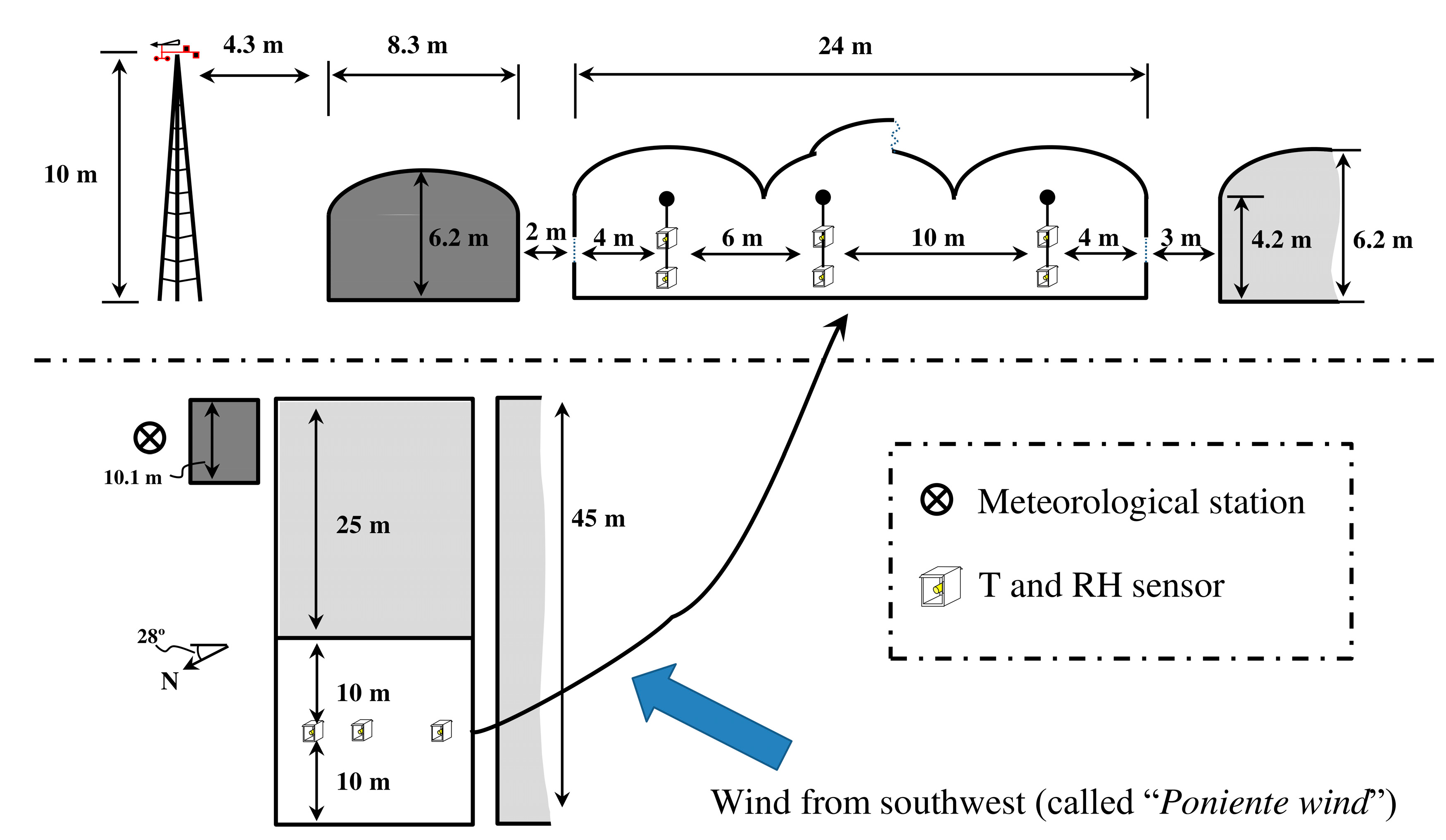
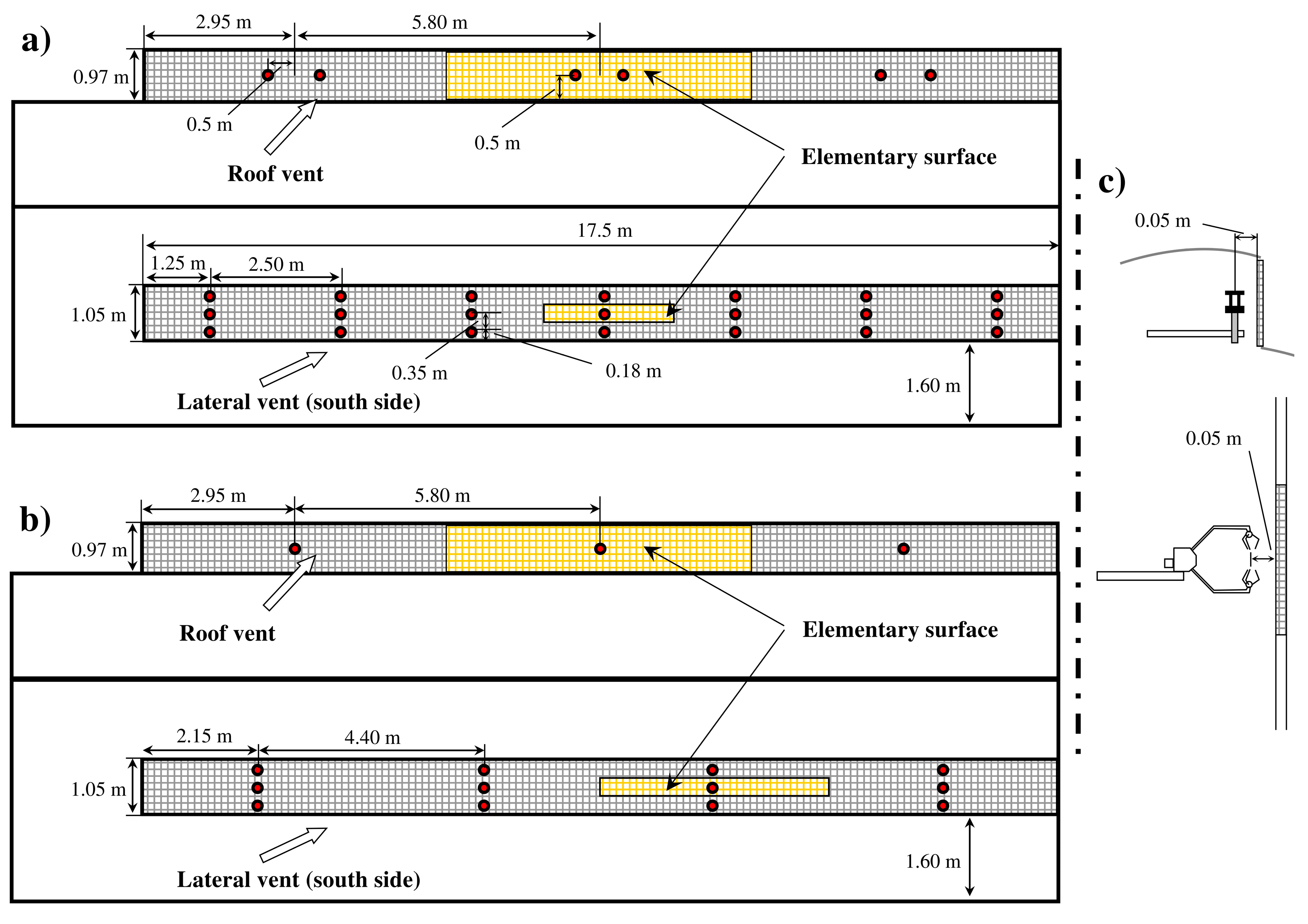

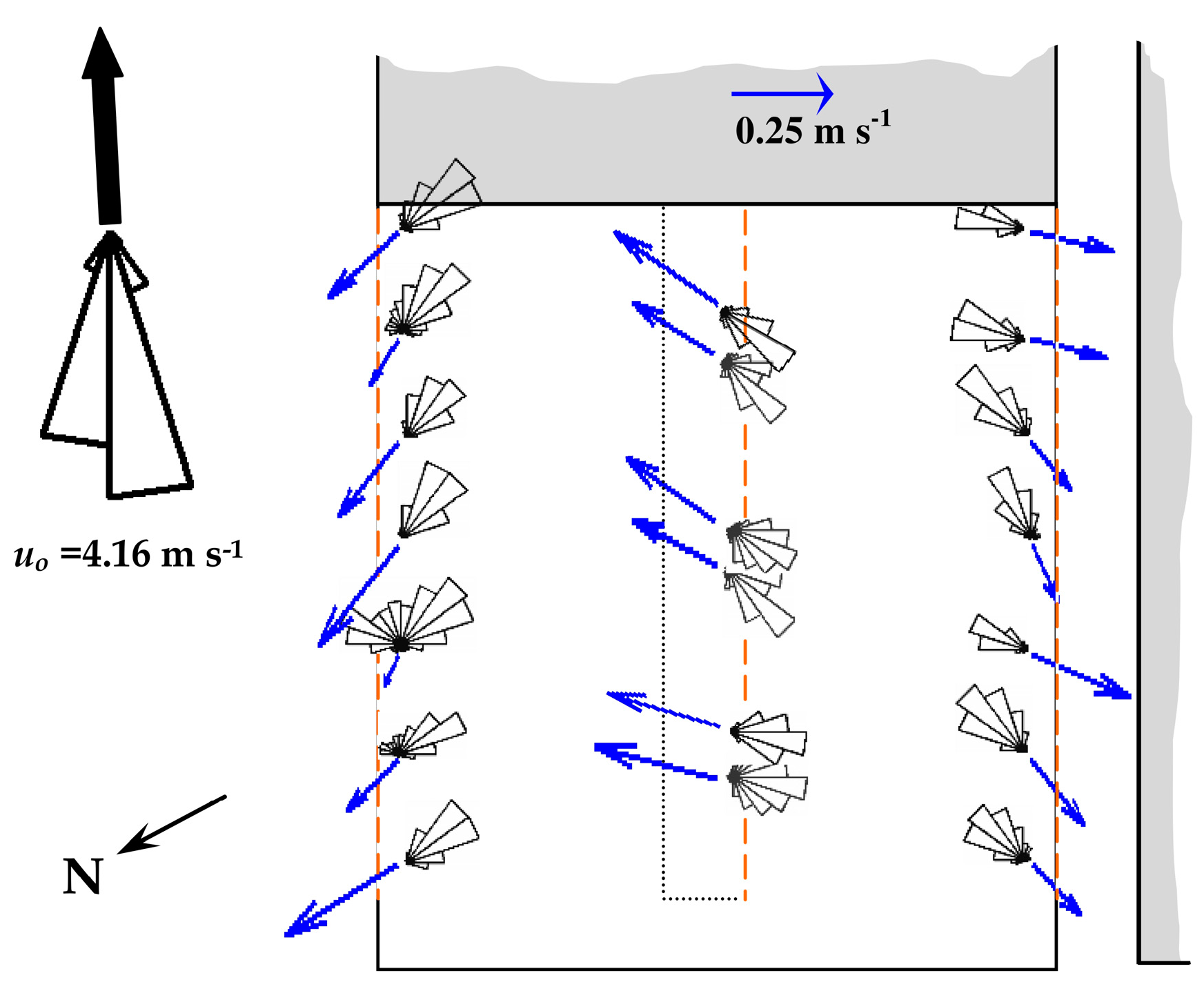

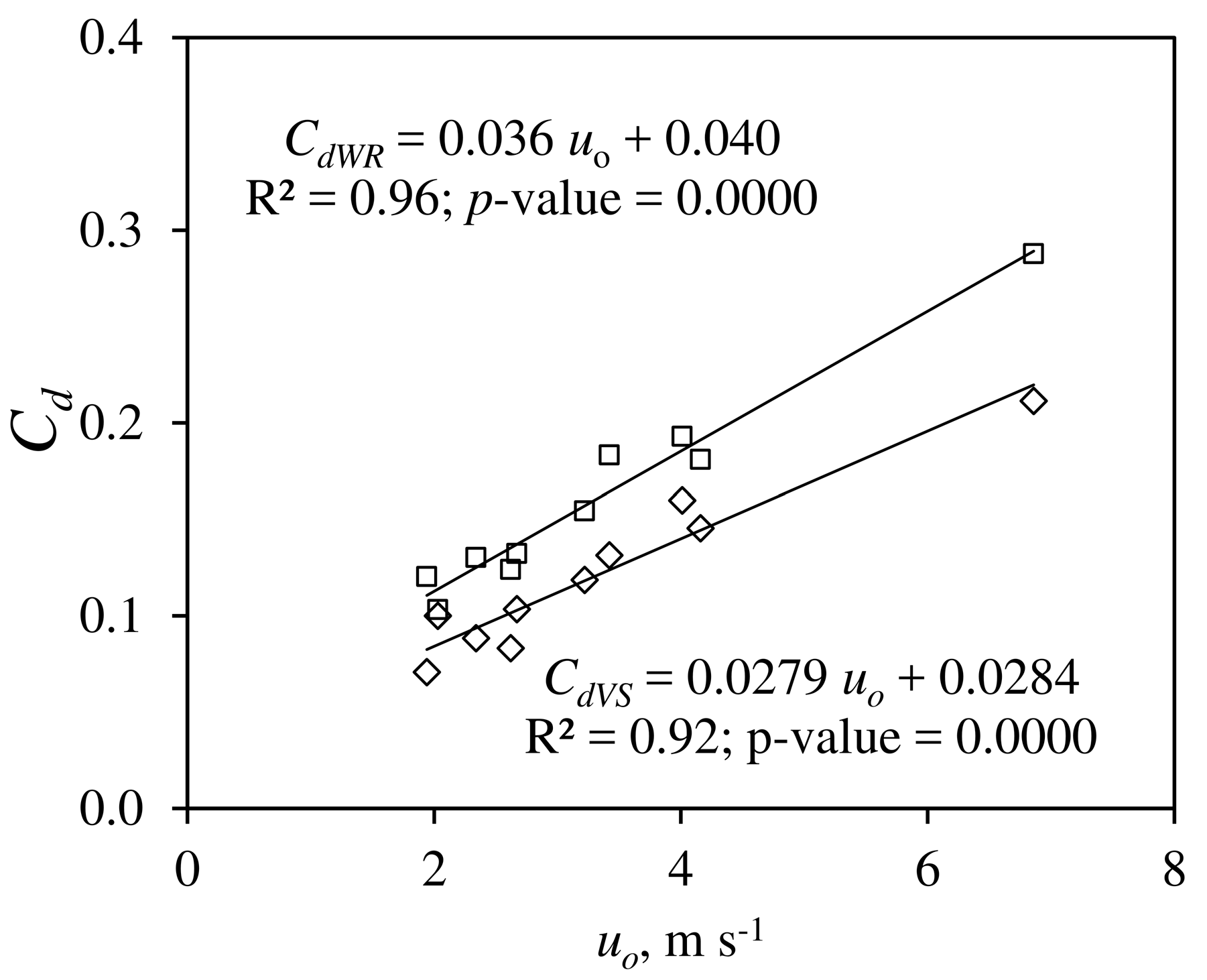
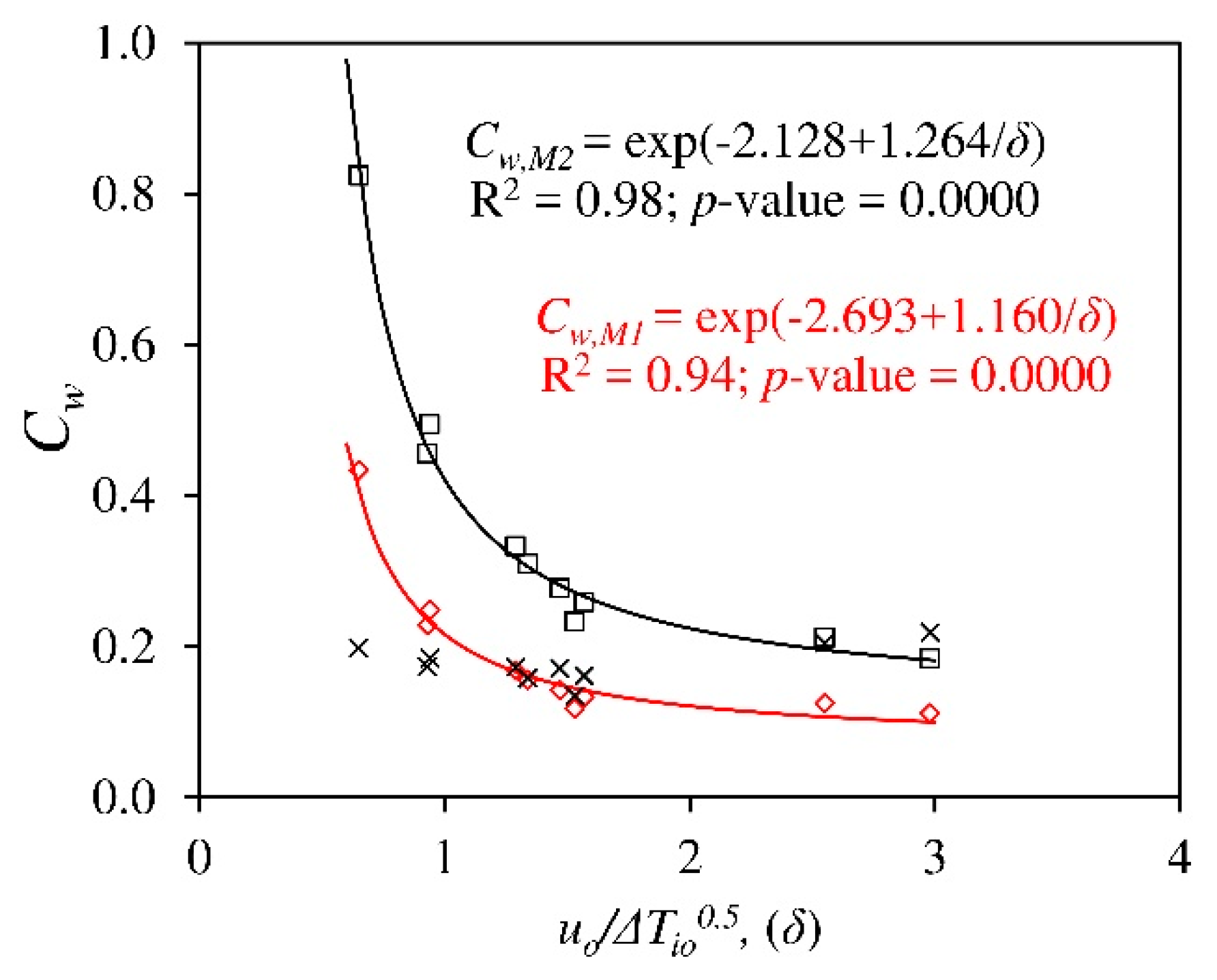
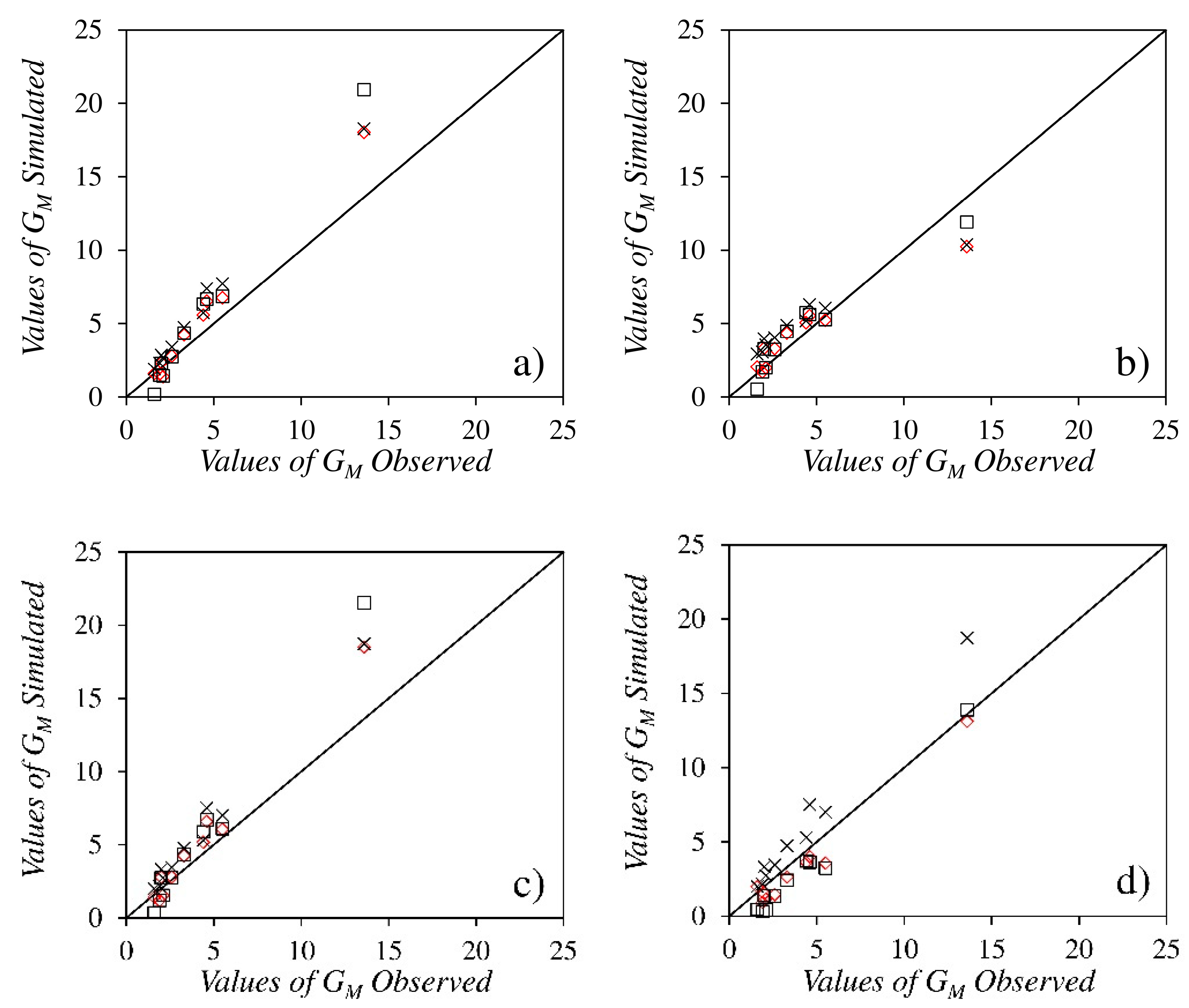
| Test | Date | Time | uo | θa | RHo | RHi | To | Ti | Rg | uo/∆Tio0.5 |
|---|---|---|---|---|---|---|---|---|---|---|
| 1 | 07/04/2009 | 11:52–14:47 | 6.86 ± 1.41 | 300 ± 7 | 67 ± 2 | 52 ± 7 | 17.5 ± 0.4 | 22.8 ± 1.9 | 527 ± 259 | 2.98 |
| 2 | 08/04/2009 | 10:49–13:31 | 4.16 ± 1.06 | 295 ± 15 | 29 ± 8 | 38 ± 2 | 18.3 ± 0.4 | 25.7 ± 1.4 | 562 ± 237 | 1.53 |
| 3 | 14/04/2009 | 11:21–14:01 | 4.01 ± 1.13 | 294 ± 10 | 72 ± 2 | 57 ± 2 | 16.3 ± 0.6 | 23.7 ± 0.7 | 692 ± 108 | 1.47 |
| 4 | 07/05/2009 | 10:56–12:36 | 2.03 ± 0.84 | 264 ± 14 | 36 ± 3 | 60 ± 5 | 22.8 ± 0.7 | 27.6 ± 0.6 | 784 ± 60 | 0.93 |
| 5 | 17/04/2009 | 11:06–13:07 | 1.94 ± 0.70 | 226 ± 25 | 59 ± 5 | 53 ± 4 | 16.9 ± 0.4 | 25.7 ± 1.0 | 584 ± 175 | 0.65 |
| 6 | 23/04/2009 | 11:23–13:16 | 2.34 ± 0.98 | 267 ± 14 | 38 ± 2 | 55 ± 6 | 22.1 ± 0.6 | 28.3 ± 0.1 | 809 ± 56 | 0.94 |
| 7 | 22/06/2009 | 11:14–12:58 | 3.42 ± 0.50 | 258 ± 8 | 56 ± 4 | 70 ± 2 | 25.5 ± 0.4 | 27.2 ± 0.5 | 617 ± 71 | 2.57 |
| 8 | 26/06/2009 | 11:17–13:04 | 2.67 ± 0.72 | 227 ± 20 | 64 ± 2 | 73 ± 3 | 24.0 ± 0.5 | 28.2 ± 0.2 | 751 ± 102 | 1.29 |
| 9 | 02/07/2009 | 11:00–12:45 | 2.62 ± 0.63 | 239 ± 17 | 65 ± 3 | 76 ± 3 | 27.0 ± 0.9 | 30.8 ± 0.4 | 725 ± 68 | 1.34 |
| 10 | 02/07/2009 | 14:41–16:28 | 3.22 ± 0.48 | 242 ± 14 | 60 ± 2 | 69 ± 2 | 28.0 ± 0.8 | 32.1 ± 0.5 | 868 ± 37 | 1.58 |
| Type | Model | Manufacturer | Measurements | Measurement Range | Resolution | Accuracy |
|---|---|---|---|---|---|---|
| 3D sonic Anemometer | CSAT3 | Campbell Scientific Spain S.L | Air velocity (ux, uy and uz) and air temperature | 0–30 m s−1 −30–50 °C | 0.001 m s−1 0.002 °C | ±0.001 m s−1 ±0.002 °C |
| 2D sonic Anemometer | Windsonic | Gill Instrument LTD | Air velocity (ux and uy) | 0–60 m s−1 0–359° | 0.01 m s−1 1° | 2% 3° |
| Temperature Pt1000 and capacitive humidity sensor | BUTRON II | Hortimax S.L. | Air temperature and humidity | −25–75 °C 0–100% | 0.01 °C 1% | ±0.01 °C ±3% |
| Cup anemomer and vane | Meteostation II | Hortimax S.L. | Wind velocity Wind direction | 0–40 m s−1 0–359° | 0.1 m s−1 1° | ±5% ±5% |
| Radiation sensor | Kipp Solari | Hortimax S.L. | Solar radiation | 0–2000 W m−2 | 0.1 W m−2 | ±20 W m−2 |
| Termistor and capacitive humidity sensor | HOBO Pro Temp-RH U23-001 | Onset Computer Corp. | Air temperature and humidity | −40–75 °C 0–100% | 0.02 °C 0.03% | ±0.18 °C ±3% |
| Test Number | ux, [m s−1] | ux*, [m s−1] | |||
|---|---|---|---|---|---|
| LS | WS | WR | LS | WS | |
| 1 | −0.42 ± 0.13 | −0.29 ± 0.11 | 0.83 ± 0.29 | −0.42 | −0.29 |
| 2 | −0.14 ± 0.06 | −0.14 ± 0.06 | 0.30 ± 0.09 | −0.14 | −0.15 |
| 3 | −0.17 ± 0.06 | −0.16 ± 0.07 | 0.27 ± 0.04 | −0.18 | −0.17 |
| 4 | 0.03 ± 0.04 | −0.11 ± 0.05 | 0.07 ± 0.02 | 0.03 | −0.11 |
| 5 | −0.02 ± 0.06 | −0.08 ± 0.06 | 0.09 ± 0.03 | −0.01 | −0.08 |
| 6 | −0.01 ± 0.06 | −0.12 ± 0.08 | 0.11 ± 0.02 | 0.02 | −0.11 |
| 7 | −0.09 ± 0.07 | −0.17 ± 0.05 | 0.25 ± 0.06 | −0.08 | −0.17 |
| 8 | 0.01 ± 0.08 | −0.15 ± 0.05 | 0.12 ± 0.05 | 0.03 | −0.14 |
| 9 | 0.00 ± 0.06 | −0.11 ± 0.04 | 0.11 ± 0.05 | −0.01 | −0.11 |
| 10 | −0.06 ± 0.13 | −0.14 ± 0.03 | 0.17 ± 0.05 | −0.06 | −0.14 |
| Test | GLS [m3 s−1] | GWS [m3 s−1] | GWR [m3 s−1] | GM [m3 s−1] | EG, [%] | G’LS [m3 s−1] | G’WS [m3 s−1] | G’WR [m3 s−1] | RM [h−1] |
|---|---|---|---|---|---|---|---|---|---|
| 1 | −7.8 | −5.3 | 14.1 | 13.6 | 7.5 | 4.1 | 4.0 | 8.2 | 18.2 |
| 2 | −2.6 | −2.7 | 4.0 | 4.6 | −27.8 | 2.2 | 1.9 | 4.0 | 6.2 |
| 3 | −3.3 | −3.2 | 4.6 | 5.5 | −33.6 | 2.6 | 2.3 | 4.0 | 7.4 |
| 4 | 0.6 | −2.0 | 1.2 | 1.9 | −11.4 | 1.7 | 1.2 | 2.6 | 2.6 |
| 5 | −0.1 | −1.5 | 1.59 | 1.6 | 1.8 | 2.1 | 1.8 | 3.0 | 2.1 |
| 6 | 0.3 | −2.0 | 1.94 | 2.1 | 12.3 | 1.6 | 1.3 | 2.9 | 2.8 |
| 7 | −1.5 | −3.1 | 4.30 | 4.4 | −6.2 | 1.6 | 1.3 | 3.3 | 6.0 |
| 8 | 0.5 | −2.6 | 2.03 | 2.6 | −5.3 | 1.8 | 1.2 | 3.3 | 3.5 |
| 9 | −0.2 | −2.0 | 1.80 | 2.0 | −20.8 | 1.4 | 1.0 | 3.0 | 2.7 |
| 10 | −1.2 | −2.6 | 2.93 | 3.3 | −24.3 | 1.9 | 1.3 | 3.4 | 4.5 |
| Test | CdLS | CdWS | CdVS | CdWR |
|---|---|---|---|---|
| 1 | 0.227 | 0.196 | 0.211 | 0.288 |
| 2 | 0.144 | 0.147 | 0.145 | 0.181 |
| 3 | 0.161 | 0.158 | 0.160 | 0.193 |
| 4 | 0.073 | 0.127 | 0.100 | 0.103 |
| 5 | 0.030 | 0.111 | 0.071 | 0.120 |
| 6 | 0.050 | 0.126 | 0.088 | 0.130 |
| 7 | 0.110 | 0.153 | 0.131 | 0.183 |
| 8 | 0.063 | 0.143 | 0.103 | 0.132 |
| 9 | 0.040 | 0.126 | 0.084 | 0.124 |
| 10 | 0.097 | 0.140 | 0.119 | 0.154 |
| Average | 0.100 ± 0.062 | 0.143 ± 0.023 | 0.121 ± 0.042 | 0.161 ± 0.054 |
| Test | Cw | Ev | ||||
|---|---|---|---|---|---|---|
| Original | Modified | M3 | M3 | |||
| M1 | M2 | M1 | M2 | |||
| 1 | 0.085 | 0.039 | 0.111 | 0.184 | 0.218 | 0.110 |
| 2 | 0.023 | 0.002 | 0.117 | 0.233 | 0.134 | 0.087 |
| 3 | 0.041 | 0.006 | 0.141 | 0.277 | 0.171 | 0.052 |
| 4 | 0.015 | 0.000 | 0.228 | 0.455 | 0.173 | 0.064 |
| 5 | −0.188 | 0.043 | 0.433 | 0.824 | 0.198 | 0.038 |
| 6 | −0.030 | 0.002 | 0.248 | 0.494 | 0.184 | 0.044 |
| 7 | 0.089 | 0.037 | 0.124 | 0.211 | 0.204 | 0.101 |
| 8 | 0.035 | 0.004 | 0.168 | 0.333 | 0.173 | 0.035 |
| 9 | 0.021 | 0.001 | 0.155 | 0.309 | 0.158 | 0.058 |
| 10 | 0.044 | 0.007 | 0.133 | 0.258 | 0.161 | 0.079 |
| Average | 0.013 ± 0.079 | 0.014 ± 0.018 | 0.186 ± 0.098 | 0.358 ± 0.192 | 0.177 ± 0.025 | 0.060 ± 0.023 |
| M | Cw | Ev | Cd | Greenhouse Type | Method * | SA | uo | Source | ||
| Without Insect-Proof Screens | ||||||||||
| M1 | 0.079 | 0.210 | 0.754 | Multi-span | Gas | 416 | 0–8 | [11] | ||
| M1 | 0.09 | 0.204 | 0.68 | Multi-span | Gas | 416 | 0–8 | [4] | ||
| M1 | 0.098 | 0.175 | 0.56 | Multi-span | Gas | 242 | 1–3 | [14] | ||
| M1 | 0.103 a | 0.210 | - | Multi-span | Gas | 179 | 0.5–2.7 | [16] | ||
| M1 | 0.116 | 0.303 | 0.89 | Multi-span | Gas | 242 | 1–3 | [14] | ||
| M1 | 0.12 | 0.208 | 0.6 | Tunnel | Gas | 416 | 2 | [2] | ||
| M1 | 0.13 | 0.252 | 0.7 | Multi-span | Gas | 416 | 0–8 | [4] | ||
| M2 | 0.1 | 0.178 | 0.42 | Multi-span | Gas | 416 | 0–8 | [4] | ||
| M3 | 0.012 a | 0.07–0.18 | - | Tunnel | Gas | 240 | 1–2 | [10] | ||
| M3 | 0.04 a | 0.131 | - | Tunnel | Om | 368 | 5 | [15] | ||
| M3 | 0.085 a | 0.190 | - | Multi-tunnel | Gas | 416 | 5.3 | [10] | ||
| M3 | 0.173 a | 0.270 | - | Multi-span | Gas | 10000 | 2–4 | [12] | ||
| M | φ | Cw | Ev | Cd | Greenhouse Type | Method * | SA | uo | Source | |
| With Insect-Proof Screens | ||||||||||
| M1 | 0.34 | 0.048 | 0.043 | 0.194 | Almería | 3D | 1694 | 5.71 | [19] | |
| M2 | 0.34 | 0.021 | 0.028 | 0.194 | Almería | 1694 | 5.71 | [19] | ||
| M3 | 0.34 | 0.066 | 0.050 | 0.194 | Almería | 1694 | 5.71 | [19] | ||
| M3 | 0.5 | 0.022 a | 0.096 | - | Single tunnel | Gas | 160 | 2.2 | [17] | |
| M3 | 0.35 | 0.071 | 0.069 | 0.253 | Single tunnel | Gas/H2O/3D | 74.4 | 4.5 | [18] | |
| M3 | 0.69 | 0.110 | 0.140 | 0.42 | Canary | Gas | 5600 | 1-2 | [13] | |
| Application i | Application ii | |||||
| M1 | M2 | M3 | M1 | M2 | M3 | |
| R2 | 0.992 | 0.991 | 0.992 | 0.925 | 0.919 | 0.952 |
| RMSD | 1.7 | 2.6 | 2.0 | 1.3 | 1.0 | 1.7 |
| RMSD (%) | 40 | 62 | 48 | 31 | 24 | 40 |
| MD | −0.9 | −1.2 | −1.5 | −0.1 | −0.2 | −0.9 |
| NSE | 0.8 | 0.4 | 0.7 | 0.9 | 0.9 | 0.8 |
| PBIAS | −22.0 | −28.0 | −36.9 | −2.7 | −5.1 | −21.0 |
| RSR | 1.6 | 2.5 | 1.9 | 1.2 | 1.0 | 1.6 |
| Application iii | Application iv | |||||
| M1 | M2 | M3 | M1 | M2 | M3 | |
| R2 | 0.986 | 0.986 | 0.987 | 0.973 | 0.980 | 0.987 |
| RMSD | 1.8 | 2.7 | 2.1 | 0.9 | 1.3 | 2.1 |
| RMSD (%) | 42 | 65 | 50 | 23 | 30 | 50 |
| MD | −0.9 | −1.2 | −1.5 | 0.8 | 1.1 | −1.5 |
| NSE | 0.7 | 0.4 | 0.6 | 0.9 | 0.9 | 0.6 |
| PBIAS | −20.7 | −27.7 | −36.9 | 18.4 | 25.9 | −36.9 |
| RSR | 1.7 | 2.6 | 2.0 | 0.9 | 1.2 | 2.0 |
| Model M1 | Model M2 | ||||||
|---|---|---|---|---|---|---|---|
| Test | uo | GT * | Gw | GT/Gw | GT * | Gw | GT/Gw |
| 1 | 6.86 | −5.1 | 14.1 | 0.36 | −5.1 | 19.0 | 0.27 |
| 2 | 4.16 | −4.0 | 5.6 | 0.70 | −4.0 | 7.6 | 0.52 |
| 3 | 4.01 | −3.9 | 5.3 | 0.73 | −3.9 | 7.1 | 0.54 |
| 4 | 2.03 | −1.9 | 1.6 | 1.15 | −1.9 | 2.9 | 0.85 |
| 5 | 1.94 | −2.5 | 1.5 | 1.66 | −2.5 | 2.0 | 1.23 |
| 6 | 2.34 | −2.4 | 2.1 | 1.14 | −2.4 | 2.8 | 0.85 |
| 7 | 3.42 | −1.6 | 4.0 | 0.41 | −1.6 | 5.4 | 0.31 |
| 8 | 2.67 | −2.1 | 2.6 | 0.83 | −2.1 | 3.5 | 0.61 |
| 9 | 2.62 | −2.0 | 2.5 | 0.79 | −2.0 | 3.4 | 0.59 |
| 10 | 3.22 | −2.4 | 3.6 | 0.67 | −2.4 | 4.8 | 0.50 |
| Average | 0.85 | Average | 0.63 | ||||
© 2019 by the authors. Licensee MDPI, Basel, Switzerland. This article is an open access article distributed under the terms and conditions of the Creative Commons Attribution (CC BY) license (http://creativecommons.org/licenses/by/4.0/).
Share and Cite
López-Martínez, A.; Molina-Aiz, F.D.; Valera-Martínez, D.L.; López-Martínez, J.; Peña-Fernández, A.; Espinoza-Ramos, K.E. Application of Semi-Empirical Ventilation Models in A Mediterranean Greenhouse with Opposing Thermal and Wind Effects. Use of Non-Constant Cd (Pressure Drop Coefficient Through the Vents) and Cw (Wind Effect Coefficient). Agronomy 2019, 9, 736. https://doi.org/10.3390/agronomy9110736
López-Martínez A, Molina-Aiz FD, Valera-Martínez DL, López-Martínez J, Peña-Fernández A, Espinoza-Ramos KE. Application of Semi-Empirical Ventilation Models in A Mediterranean Greenhouse with Opposing Thermal and Wind Effects. Use of Non-Constant Cd (Pressure Drop Coefficient Through the Vents) and Cw (Wind Effect Coefficient). Agronomy. 2019; 9(11):736. https://doi.org/10.3390/agronomy9110736
Chicago/Turabian StyleLópez-Martínez, Alejandro, Francisco D. Molina-Aiz, Diego L. Valera-Martínez, Javier López-Martínez, Araceli Peña-Fernández, and Karlos E. Espinoza-Ramos. 2019. "Application of Semi-Empirical Ventilation Models in A Mediterranean Greenhouse with Opposing Thermal and Wind Effects. Use of Non-Constant Cd (Pressure Drop Coefficient Through the Vents) and Cw (Wind Effect Coefficient)" Agronomy 9, no. 11: 736. https://doi.org/10.3390/agronomy9110736
APA StyleLópez-Martínez, A., Molina-Aiz, F. D., Valera-Martínez, D. L., López-Martínez, J., Peña-Fernández, A., & Espinoza-Ramos, K. E. (2019). Application of Semi-Empirical Ventilation Models in A Mediterranean Greenhouse with Opposing Thermal and Wind Effects. Use of Non-Constant Cd (Pressure Drop Coefficient Through the Vents) and Cw (Wind Effect Coefficient). Agronomy, 9(11), 736. https://doi.org/10.3390/agronomy9110736






